Photo: John Lamparski/Getty Images
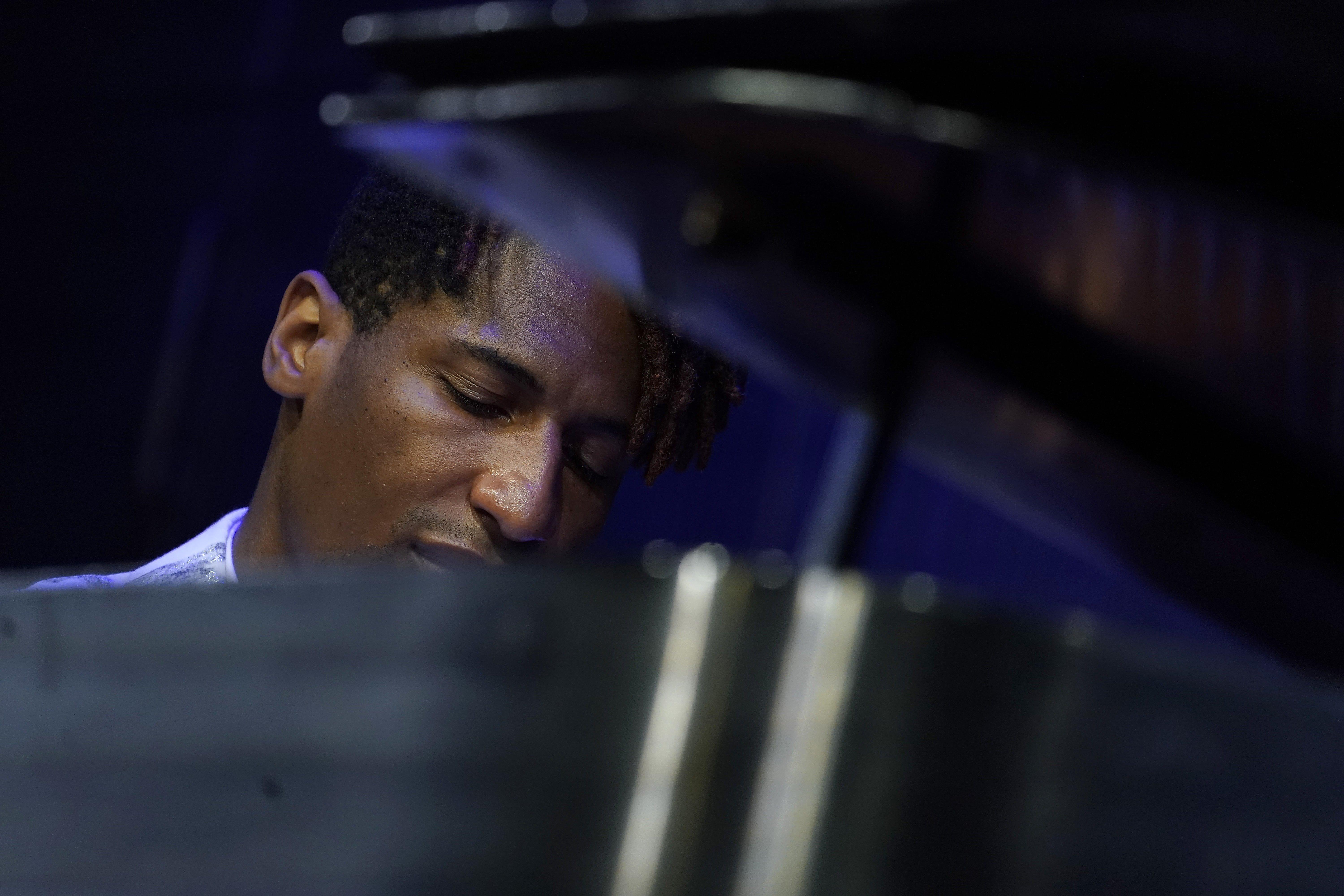
feature
Jon Batiste Kicks Off The GRAMMY Museum's "A New York Evening With…" Series With Revealing Q&A, Intimate Solo Performance
"I feel like everyone here, I'd probably like a lot," Batiste told the gobsmacked and masked audience at Lincoln Center — reminding them that he isn't just a GRAMMY-sweeping musical juggernaut, but a highly present human being.
Jon Batiste has been a household name since 2015, but he's seemingly just now arriving as an honest-to-goodness star.
By the time he took the stage at a small auditorium at Lincoln Center on June 17, he had been up for a scarily long time — beginning with an early appearance on "The Today Show" that morning. Still, Batiste's natural charisma was undimmed. Almost immediately, the beyond-media-trained musician laid waste to the N95-ed audience — and all it took was a quick shimmy and a gleaming grin.
If all Batiste did at the New York Performing Arts Library was smile and dance and wave, it would have amounted to an Instagrammable moment, at the very least. Instead, the house was in for an uncommonly deep Q&A and performance, to kick off the GRAMMY Museum's "A New York Evening With…" series presented by City National Bank and in partnership with the City of New York Mayor's Office of Media and Entertainment. (It'll run until the end of 2022; click here for more details.)
Speaking with the GRAMMY Museum's Chief Curator and VP of Curatorial Affairs, Jasen Emmons, Batiste held forth about his childhood, family life, and constant potpourri of creative projects — which spans everything from film to TV to Carnegie Hall to lower-key collaborations. Batiste followed it up with an audience Q&A and then a livewire, seemingly improvisatory set on piano and voice, threading his GRAMMY-winning originals with standards germane to Black America.
*Jon Batiste speaking with the GRAMMY Museum’s Jasen Emmons. Photo: John Lamparski/Getty Images*
Back to all those projects for a second. How, exactly, does Batiste juggle it all? The words "frontburner" and "backburner" came up several times. His American Symphony, coming up at Carnegie was on the backburner for years until it was on the front. A good-intentioned request from an audience member to work in Broadway? "I've never really decided I want to focus on that on the front burner," he replied. "I think it has to be the right project."
Elsewhere in the hour-long talk, Batiste rhapsodized about his hometown of New Orleans ("We also have this incredible family that is musical, and this incredible city that's musical, and everybody plays"), revealed that he sweats over lyrics ("That's the hardest part, in that it takes the most time") and decried the notion of "world music" ("I want to abolish that, actually").
On top of all that, he recalled meeting Stephen Colbert for the first time and described the philosophy he brought to the Pixar film Soul, which he and other blue-chip jazz musicians like Herbie Hancock, Terri Lyne Carrington and Aaron Diehl chipped into. "It was a real labor of love to really make it right, make it feel authentic," Batiste said "We really went for it."
Stars at Batiste's level can be inaccessible, an entertainment module more than an approachable person. Batiste is the opposite. The Q&A radiated love for his family, roots, and future friends; his old piano teacher was even in the audience. And the brief set Batiste performed afterward didn't feel predetermined or prepackaged; it felt like a genuine expression in the moment.
Weaving originals like "We Are" and "Cry" with shopworn tunes like "Sinner Man," "St. James Infirmary Blues" and Bill Withers' "Ain't No Sunshine," Batiste made celestial connections between music's past — which he clearly, deeply understands — and his present. Between tunes, he almost seemed taken aback at what had transpired, like he was observing himself. "I was just playing," he quietly noted at one point. "I like that."
*Jon Batiste performing post-Q&A. Photo: John Lamparski/Getty Images*
The piano-and-a-microphone set — which contained material from his 2022 GRAMMYs-sweeping album We Are provided a window into how talented this guy truly is. But at a certain point, it all came back to that born starpower. Perhaps maintaining it means not being thrown off by an early morning, or the fact he couldn't see anyone's full faces. Maybe it means tapping into a shared energy, no matter what.
"I feel like everyone here, I'd probably like a lot," Batiste said before performing his final song of the night, "We Are." And from the sound of the enraptured crowd at Lincoln Center, the answer was clear: back atcha.
Check below for more details on the "A New York Evening With…" series, and keep checking RecordingAcademy.com for more recaps of these intimate, unforgettable East Coast evenings — courtesy of the GRAMMY Museum.
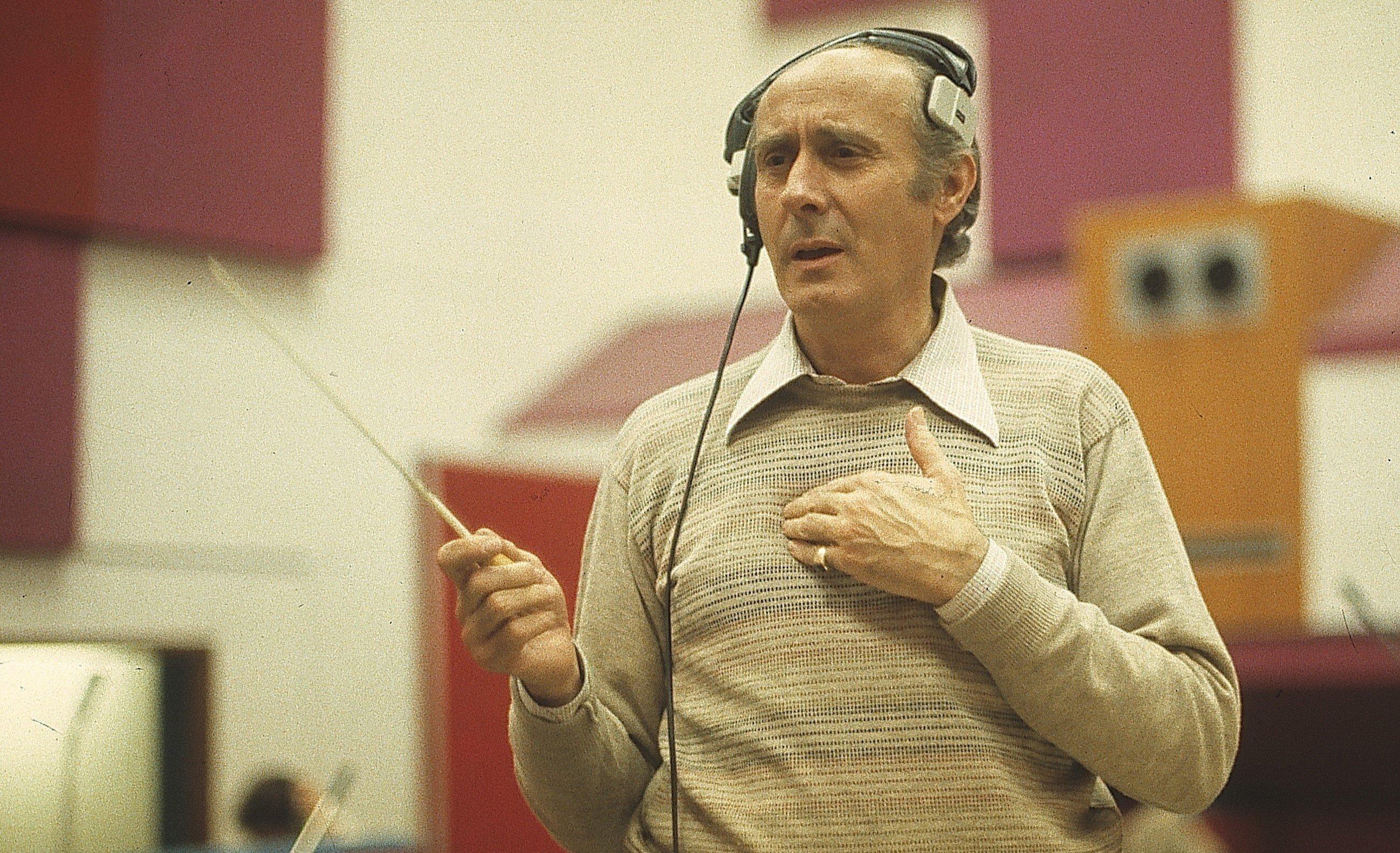
Photo: A. Schorr/ullstein bild via Getty Images
list
10 Essential Henry Mancini Recordings: From "Moon River" To The 'Pink Panther' Theme
Composer, arranger, conductor and pianist Henry Mancini won 20 GRAMMY Awards over his legendary career. On what would be his 100th birthday, revisit 10 timeless Henry Mancini compositions.
Henry Mancini had a gift for melodies of an ethereal, almost supernatural beauty.
His prolific discography — albums of jazzy orchestral pop, dozens of film and television soundtracks — established him as a cultural icon and transformed the role that melody and song played in the art of movie narrative. Once you encounter a Henry Mancini tune, it’s almost impossible not to start humming it.
A composer, arranger, conductor and pianist of tireless discipline, Mancini won a staggering 20 GRAMMY Awards and was nominated 72 times. All of his wins — including the first-ever golden gramophone for Album Of The Year at the inaugural 1959 GRAMMYs — will be on display at the GRAMMY Museum to honor his centennial birthday, April 16.
To mark what would be his centennial birthday, Mancini's children will travel to Abruzzo, Italy — where Mancini’s parents migrated from. And on June 23, the Hollywood Bowl Orchestra will present a program of his music with a gallery of guest stars including singer Monica Mancini, the maestro’s daughter. Out June 21, The Henry Mancini 100th Sessions – Henry Has Company will feature a new recording of "Peter Gunn" conducted by Quincy Jones and featuring John Williams, Herbie Hancock and Arturo Sandoval.
Although Mancini died in 1994 at age 70, his compositions remain timeless and ever-relevant. Read on for 10 essential Henry Mancini compositions to cherish and rediscover.
"Peter Gunn" (1958)
In 1958, Mancini was looking for work and used his old Universal studio pass to enter the lot and visit the barber shop. It was outside the store that he met writer/director Blake Edwards and got the chance to write the music for a new television show about private detective Peter Gunn.
Seeped in West Coast Jazz, Mancini’s main theme sounds brash and exciting to this day – its propulsive beat and wailing brass section evoking an aura of cool suspense. The "Peter Gunn" assignment cemented his reputation as a cutting-edge composer, and the accompanying album (The Music From Peter Gunn) won GRAMMYs in the Album Of The Year and Best Arrangement categories.
"Mr. Lucky" (1959)
Half of the "Peter Gunn" fan mail was addressed to Mancini. As a result, CBS offered Blake Edwards a second television show, as long as the composer was part of the package. Edwards created "Mr. Lucky," a stylish series about the owner of a floating casino off the California coast.
1959 was an exhausting year for Mancini, as he was scoring two shows at the same time on a weekly basis. Still, his music flowed with elegance and ease. The "Mr. Lucky" ambiance allowed him to explore Latin rhythms, and the strings on his wonderful main theme shimmer with a hint of yearning. It won GRAMMY Awards in 1960 for Best Arrangement and Best Performance by an Orchestra.
"Lujon" (1961)
As part of his contract with RCA Victor, Mancini was committed to recording a number of albums featuring original compositions in the same velvety jazz-pop idiom from his television work. "Lujon" is the standout track from Mr. Lucky Goes Latin, a collection of Latin-themed miniatures that luxuriate in a mood of plush languor.
Inspired by the complex harmonics of French composer Maurice Ravel, "Lujon" steers safely away from lounge exotica thanks to the refined qualities of the melody and arrangement.
"Moon River" (1961)
Performed on a harmonica, the main melody of "Moon River" is nostalgic to the bone, but also life affirming. A majestic string section makes the music swoon, like gliding on air. And the harmonies in the vocal chorus add gravitas — a touch of humanity.
It took Mancini half an hour to write "Moon River," but the Breakfast at Tiffany’s anthem made him a global superstar. Among the many artists who covered the song, pop crooner Andy Williams turned it into his personal anthem. Mancini won an Academy Award for Best Original Song, and GRAMMY Awards for Record Of The Year, Song Record Of The Year and Best Arrangement. The album soundtrack earned two additional gramophones.
Theme from Hatari! (1962)
After two failed attempts with different composers, legendary director Howard Hawks invited Mancini to write the score for Hatari! — the wildly episodic but oddly endearing safari film he had shot in Tanganyika with John Wayne. Mancini jumped at the opportunity, and Hawks gave him a few boxes from the trip that contained African percussive instruments, a thumb piano and a tape of Masai tribal chants. Two chords from that chant, together with a slightly detuned upright piano formed the basis for the movie’s main theme.
Mancini’s sparse arrangement and melancholy melody conspired to create one of the most gorgeous themes in the history of film.
"Days of Wine and Roses" (1962)
Throughout the decades, Mancini provided musical accompaniment to Blake Edwards’ filmography, which switched from slapstick comedy to stark melodrama. There is a perverse beauty to the theme of Days of Wine and Roses — a movie about a couple of lifelong alcoholics — as the lush choral arrangement seems to glorify the innocence of better times.
It won an Academy Award for Best Original Song — Mancini’s second Oscar in a row — and three GRAMMYs: Record Of The Year, Song Of The Year and Best Background Arrangement.
"The Pink Panther Theme" (1963)
Directed by Edwards and starring Peter Sellers as part of an ensemble cast, the original Pink Panther was a frothy caper comedy that had none of the manic touches of comedic genius that Sellers would exhibit in subsequent entries of the franchise. It was Mancini’s ineffable main theme that carried the movie through.
Jazzy and mischievous, Mancini wrote the melody with the light-as-a-feather playing of tenor saxophonist Plas Johnson in mind. It won GRAMMYs in three categories: Best Instrumental Arrangement, Best Instrumental Compositions (Other Than Jazz), and Best Instrumental Performance – Non-Jazz.
Charade (1963)
Mancini’s gift for cosmopolitan tunes and jazzy arrangements found the perfect vehicle in the score for Stanley Donen’s Charade — a droll Hitchcockian thriller shot in Paris and starring Cary Grant and Audrey Hepburn.
The main theme is a waltz in A minor, and opens with pulsating percussion. When the central melody appears, it evokes a melancholy reflection and a certain thirst for the kind of globetrotting adventure that the film delivers in spades. It was Johnny Mercer’s favorite Mancini melody, and he wrote exquisite lyrics for it.
The best version probably belongs to jazz singer Johnny Hartman, who released it as the opening track of his 1964 album I Just Dropped By To Say Hello.
Two For The Road (1967)
Friends and family remember Mancini as a humble craftsman who ignored the trappings of fame and focused on the discipline of work. In 1967, after Audrey Hepburn cabled to ask him about writing the music for the Stanley Donen film Two For The Road, Mancini agreed, but was taken aback when the director rejected his initial theme. Leaving his ego aside, he returned to the drawing board and delivered a lovely new melody – and a spiraling piano pattern seeped in old fashioned tenderness.
"Theme from The Molly Maguires" (1970)
Even though Mancini enjoyed most accolades during the ‘60s, his protean level of inspiration never wavered. In 1970, he was brought in to rescue the soundtrack of Martin Ritt’s gritty secret societies drama The Molly Maguires, about Irish-American miners rebelling against their mistreatment in 19th century Pennsylvania.
The main theme makes time stand still: a sparse arrangement that begins with a solitary harp, until a recorder ushers in a haunting, Irish-inspired melody. The score reflected a more restrained Mancini, but was still intensely emotional.
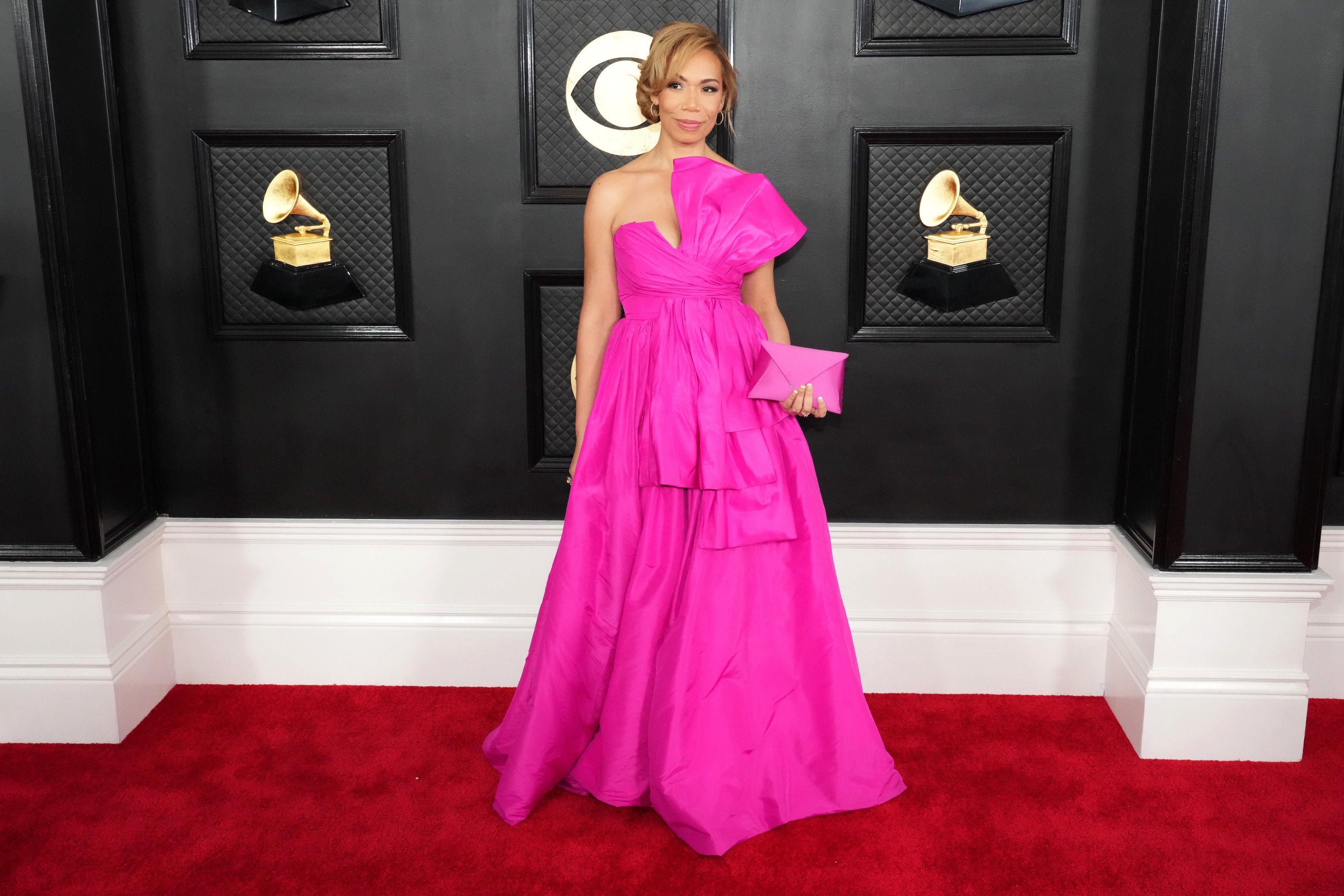
Photo: Jeff Kravitz/FilmMagic
video
Where Do You Keep Your GRAMMY?: Autumn Rowe Revisits Her Unexpected Album Of The Year Win With Jon Batiste
Acclaimed songwriter Autumn Rowe reveals the inspirational location where her Album Of The Year golden gramophone resides, and details the "really funny way" she first met Jon Batiste.
Ever since Autumn Rowe won a GRAMMY in 2022, it's been her biggest motivation. That's why the musical multi-hyphenate keeps the award nestled in her writing room — to keep her creative juices flowing.
"It reminds me that anything is possible," she says in the latest episode of Where Do You Keep Your GRAMMY?
Rowe won her first-ever career GRAMMY in 2022 with an Album Of The Year award for Jon Batiste's We Are. "It was very stressful," she recalls with a laugh.
"Right before they announced Album Of The Year, the pressure started getting to me," Rowe explains. "Album Of The Year is the biggest possible award you can win. So, I'm like, 'We didn't win any of these [categories], how are we going to win the biggest award?"
The win also taught her one unforgettable, valuable lesson: "We matter. The music matters. Everything matters. We just have to create it. If there isn't space for it, we have to make space for it. Don't wait for something to open."
Rowe says she grew up "super dirt poor" and never even had the opportunity to watch the awards ceremony on television. "To be a GRAMMY winner means it is possible for everyone," she declares.
Press play on the video above to learn more about the backstory of Autumn Rowe's Album Of The Year award, and remember to check back to GRAMMY.com for more new episodes of Where Do You Keep Your GRAMMY?
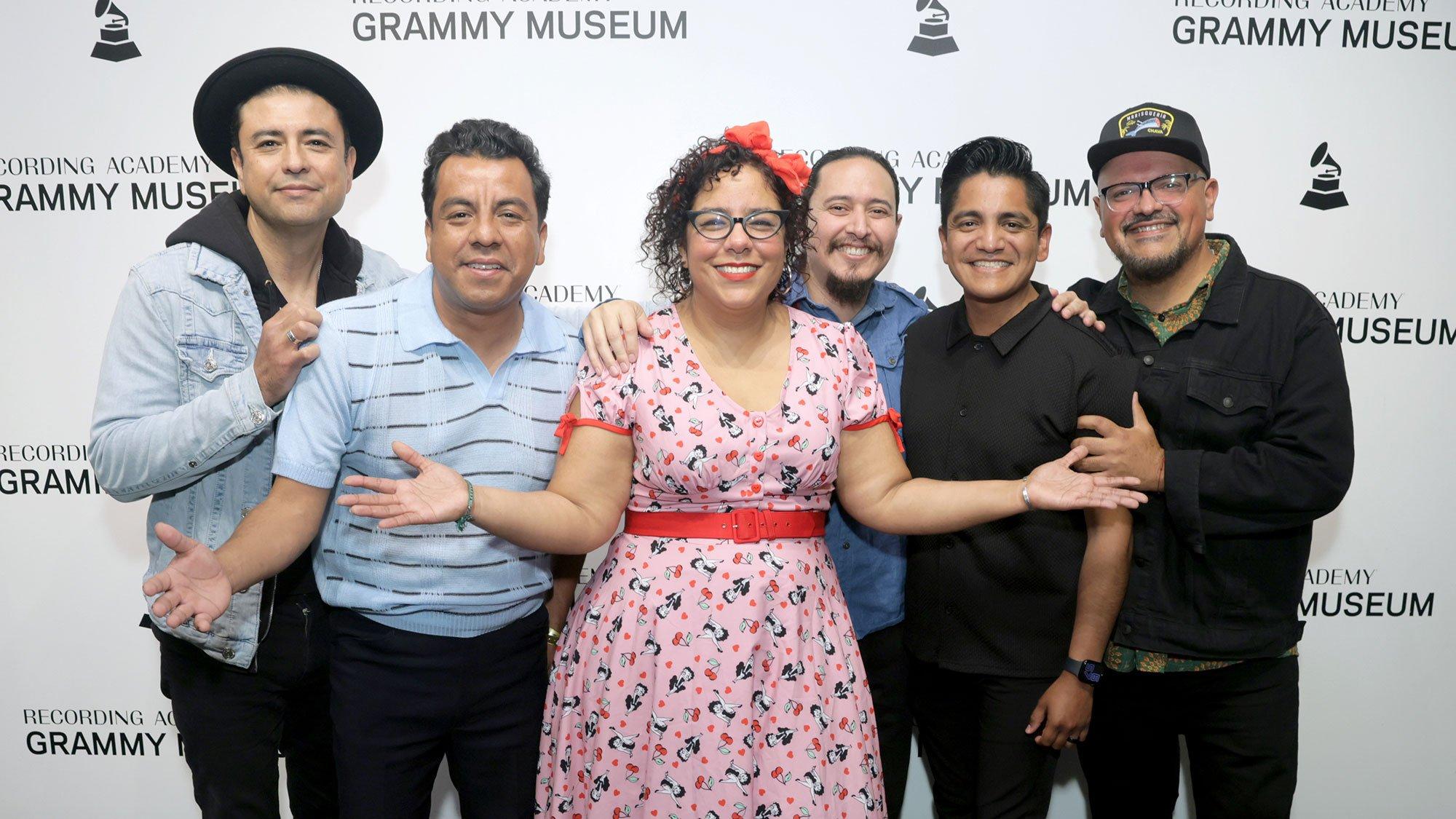
Photo: Rebecca Sapp/Getty Images for The Recording Academy
news
La Santa Cecilia Celebrates Their 'Alma Bohemia' With Documentary Screening & Performance At The GRAMMY Museum
In a documentary screening detailing the making of their album 'Cuatro Copas' followed by a discussion and live performance at the GRAMMY Museum, La Santa Cecilia recounts years of making music and friendship.
"Oh no, I’m going to start crying again," says La Santa Cecilia singer La Marisoul during a touching scene in Alma Bohemia, the documentary directed by Carlos Pérez honoring the Los Angeles band’s 15 year anniversary.
As it turns out, there are many reasons to be emotional about this film — and the very existence of La Santa Cecilia in the contemporary Latin music landscape. Fittingly, Alma Bohemia was received enthusiastically by the capacity audience during an exclusive screening on April 3 at the GRAMMY Museum’s Clive Davis Theater in Los Angeles.
Formed by La Marisoul (real name is Marisol Hernández), bassist Alex Bendaña, accordionist and requinto player José "Pepe" Carlos and percussionist Miguel "Oso" Ramírez, La Santa Cecilia was for years one of the best kept secrets in the Los Angeles music scene. As close friends and musicians, they won over audiences with an organic, down-to-earth sound and a lovely songbook that draws from traditional formats such as bolero, ranchera and nueva canción.
Alma Bohemia follows the making of La Santa’s 2023 album, Cuatro Copas Bohemia en la Finca Altozano. A celebration of the band’s longevity, the session also functions as a subtle, yet powerful musical experiment. It was recorded at the Finca Altozano in Baja California, where the band members stayed as guests of celebrated chef Javier Plascencia — a longtime fan.
Argentine producer Sebastián Krys — the band’s longtime collaborator — calls this his Alan Lomax experiment. The album was recorded live on tape with a variety of strategically placed microphones capturing hints of ambient sonics — a sweet afternoon breeze, the clinking of glasses, the musicians’ banter, the soft sounds that accompany stillness.
From the very beginning, the making of Cuatro Copas mirrors the band’s bohemian cosmovision: A communal approach where the quartet — together with carefully selected guest stars — get together to share the magic of creation, the unity of like-minded souls, homemade food, and more than a couple of drinks. In effect, the bottles of mezcal and never ending rounds of toasting quickly become a running joke throughout the documentary.
La Marisoul’s fragile lament is enveloped in spiraling lines of mournful electric guitars with soulful understatement on the track "Almohada." Guest artists liven things up, with Oaxacan sister duo Dueto Dos Rosas adding urgency to "Pescadores de Ensenada," while son jarocho master Patricio Hidalgo ventures into a lilting (yet hopeful) "Yo Vengo A Ofrecer Mi Corazón," the ‘90s Argentine rock anthem by Fito Páez.
Visibly delighted to be part of the bohemia, 60-year-old ranchera diva Aida Cuevas steals the show with her rousing rendition of "Cuatro Copas," the José Alfredo Jiménez classic. "Viva México!" she exclaims as the entire group sits around a bonfire at night, forging the past and future of Mexican American music into one.
Read more: La Santa Cecilia Perform "Someday, Someday New"
Following the screening, the band sat down for a Q&A session hosted by journalist Betto Arcos. Sitting on the first row, a visibly moved young woman from El Salvador thanked the band for helping her to cope with the complex web of feelings entailed in migrating from Latin America. La Santa’s songs, she said, reminded her of the loving abuelita who stayed behind.
"We love the old boleros and rancheras," said La Marisoul. "We became musicians by playing many of those songs in small clubs and quinceañeras. It’s a repertoire that we love, and I don’t think that will ever change."
Carlos touched on his experience being a member of Santa Cecilia for about seven years before he was able to secure legal status in the U.S. When the band started to get concert bookings in Texas, they would take long detours on their drives to avoid the possibility of being stopped by the authorities. Carlos thanked his wife Ana for the emotional support she provided during those difficult years.
Ramírez took the opportunity to acknowledge producer Krys for being an early champion of the band. "He had a vision, and he made us better," he said, flashing forward to a recent edition of the Vive Latino festival. "There were about 12,000 people to see us," he said. "And they were singing along to our tunes."
"The band is just an excuse to hang out with your friends," added La Marisoul just before La Santa performed two live songs. Her voice sounded luminous and defiant in the theater’s intimate space, always the protagonist in the group’s delicately layered arrangements.
"The first time I got to see the finished documentary, I felt proud of all the work we’ve done together," said producer Krys from his Los Angeles studio the day after the screening. "On the other hand, there’s a lot of work ahead of us. I believe La Santa Cecilia deserves wider exposure. They should be up there among the greatest artists in Latin music."
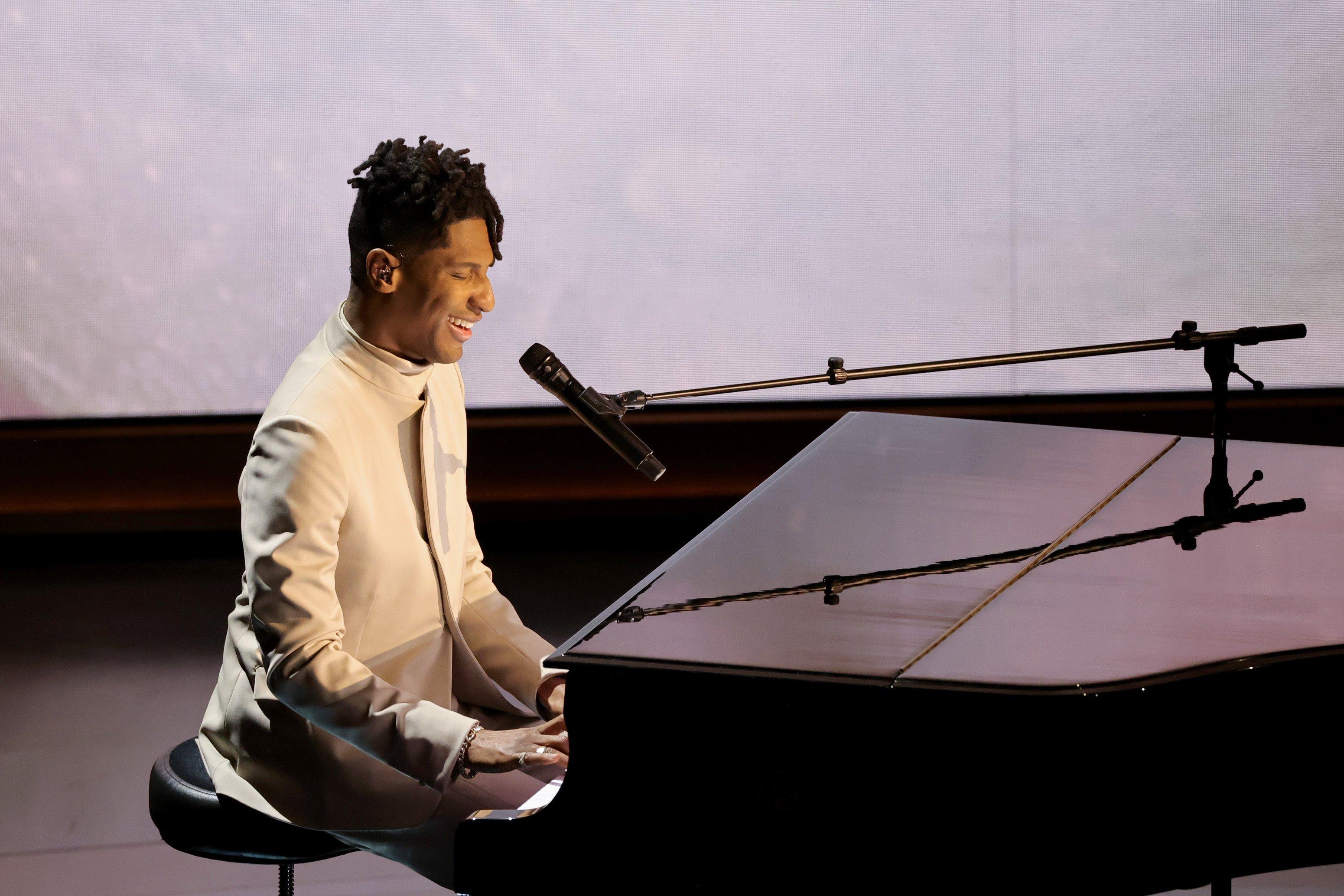
Photo: Kevin Winter/Getty Images
video
2024 Oscars: Watch Jon Batiste Perform A Poignant Rendition Of "It Never Went Away" From The Documentary Film 'American Symphony'
At the 2024 Academy Awards, five-time GRAMMY winner Jon Batiste performed a soul-nourishing version of "It Never Went Away" from ‘American Symphony,’ the acclaimed documentary film about his and wife Suleika Jaouad’s personal and creative lives.
At the 2024 Oscars on March 10, five-time GRAMMY winner and 20-time nominee Jon Batiste took the stage for a scintillating version of his co-write with Dan Wilson, "It Never Went Away."
For said performance, the multimedia phenom kept the proceedings spare and probing, letting his iridescent piano and singular pipes do the heavy lifting. Watch it above.
"It never went away/Every time I see your face," Batiste sang, in a commensurately understated, off-white stage outfit and backdrop. "The feeling's just the same/ It's never goin' away."
"It Never Went Away" was featured in the acclaimed 2023 documentary American Symphony, about his and his wife author Suleika Jaouad's personal and creative development — under the spectre of cancer and an impending debut at Carnegie Hall, of the symphony of the same name.
2024 Oscars: Watch Performances & Highlights
"It was very complicated from a producing point of view to navigate the puzzle of Jon's insane life, and then trying to find our way into the hospital, and then back out again, and back in again," American Symphony director Matthew Heineman said last year at a live interview covered by GRAMMY.com.
In the same conversation Heineman aptly described the overall process as reflecting "the symphony of life that we witnessed over the past year."
Keep checking this space for more updates on the 2024 Oscars — including GRAMMY winners and nominees who are featured during the big night!
Inside American Symphony: 5 Revelations About The Jon Batiste Documentary
